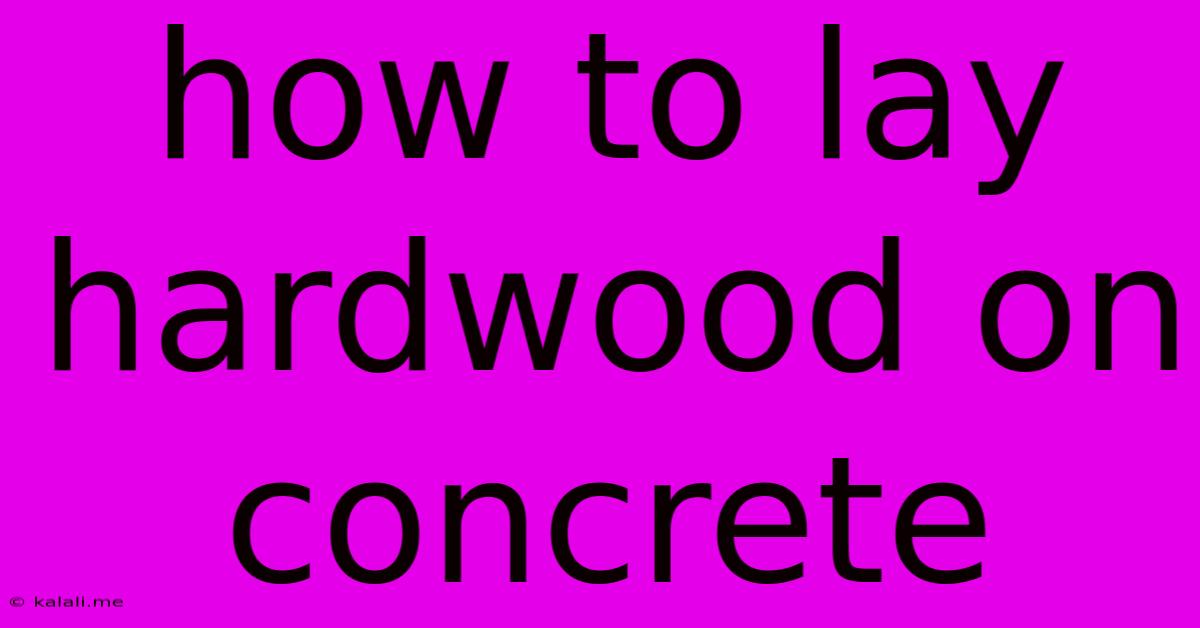How To Lay Hardwood On Concrete
Kalali
Jun 10, 2025 · 3 min read

Table of Contents
How to Lay Hardwood Flooring Over Concrete: A Comprehensive Guide
Installing hardwood flooring over concrete can dramatically enhance the look and feel of your home, adding value and warmth. However, it requires careful planning and execution to ensure a successful and long-lasting result. This comprehensive guide will walk you through each step of the process, from preparation to finishing touches. This detailed approach will help you achieve a professional-looking hardwood floor that you'll be proud of.
Understanding the Challenges & Choosing the Right Flooring:
Laying hardwood over concrete presents unique challenges. Concrete is a relatively cold, damp, and inflexible surface. Moisture migration from the concrete slab is a major concern, potentially leading to warping, cupping, or rotting of your hardwood. This necessitates careful moisture testing and the use of a proper underlayment.
Choosing the right hardwood is also crucial. Engineered hardwood is generally preferred for concrete subfloors due to its superior stability and moisture resistance compared to solid hardwood. Engineered wood is constructed with multiple layers, making it less susceptible to damage from moisture fluctuations. Look for engineered hardwood with a thick wear layer for longevity.
Step-by-Step Installation Guide:
1. Preparation is Key:
- Moisture Testing: Before starting, conduct a thorough moisture test using a moisture meter. Acceptable moisture levels vary depending on the type of hardwood and underlayment you choose; consult the manufacturer's instructions. High moisture levels may require mitigation techniques like the use of a moisture barrier.
- Surface Preparation: The concrete slab needs to be clean, level, and free of debris, cracks, and dust. Repair any significant cracks or imperfections using appropriate concrete patching compound. A smooth, level surface is essential for a successful installation.
- Vapor Barrier (Optional but Recommended): While not always necessary, a polyethylene vapor barrier is highly recommended, especially in damp climates. This layer prevents moisture from the concrete slab from migrating upwards.
2. Underlayment Installation:
- Choosing the Right Underlayment: Selecting the right underlayment is critical for mitigating moisture issues and providing insulation. Look for underlayments specifically designed for use over concrete. They often include a moisture barrier and provide sound insulation.
- Installation: Roll out the underlayment, ensuring it's neatly overlapped and taped at the seams. Follow the manufacturer's instructions for proper installation.
3. Hardwood Installation:
- Acclimation: Before installation, allow your hardwood to acclimate to the room's temperature and humidity for several days. This allows the wood to adjust and prevents expansion and contraction issues.
- Installation Method: The specific installation method will depend on your chosen hardwood and underlayment. Common methods include floating (using a click-lock system) or glue-down. Floating installations are easier for DIYers, while glue-down provides greater stability. Carefully follow the manufacturer's instructions.
- Expansion Gap: Always leave an expansion gap around the perimeter of the room. This gap allows for natural expansion and contraction of the hardwood due to temperature and humidity changes.
4. Finishing Touches:
- Transition Strips: If you're transitioning to a different flooring type, use appropriate transition strips for a seamless look.
- Baseboards: Install baseboards to conceal the expansion gap and complete the look.
5. Post-Installation Care:
- Cleaning: Sweep or vacuum regularly to remove dust and debris.
- Moisture Control: Maintain consistent temperature and humidity levels in your home to prevent moisture-related problems.
Troubleshooting Common Issues:
- Cupping or Crowning: This usually indicates moisture problems. Check moisture levels and address any underlying issues.
- Squeaking: This can be caused by loose boards or inadequate underlayment. Tighten loose boards or consider adding additional underlayment.
Installing hardwood flooring over concrete is a significant project, but with careful planning and execution, you can achieve a beautiful and long-lasting result. Remember to prioritize thorough preparation, choose the right materials, and follow the manufacturer's instructions carefully for optimal results. Don't hesitate to consult a professional if you are unsure about any aspect of the process.
Latest Posts
Latest Posts
-
The American University Of Paris Acceptance Rate
Jun 12, 2025
-
St Georges University Grenada Acceptance Rate
Jun 12, 2025
-
Uppsc Agriculture Services Pre Answer Key 2024 By Sarkarijobofficial In
Jun 12, 2025
-
City University Of New York Admissions
Jun 12, 2025
-
Attention To Detail Test Questions And Answers Pdf
Jun 12, 2025
Related Post
Thank you for visiting our website which covers about How To Lay Hardwood On Concrete . We hope the information provided has been useful to you. Feel free to contact us if you have any questions or need further assistance. See you next time and don't miss to bookmark.